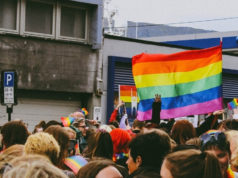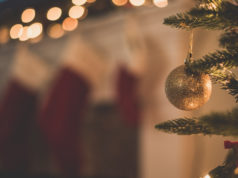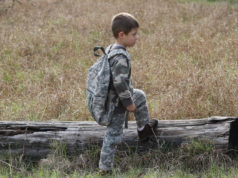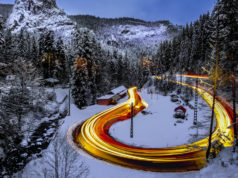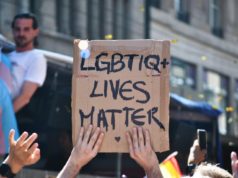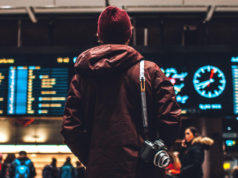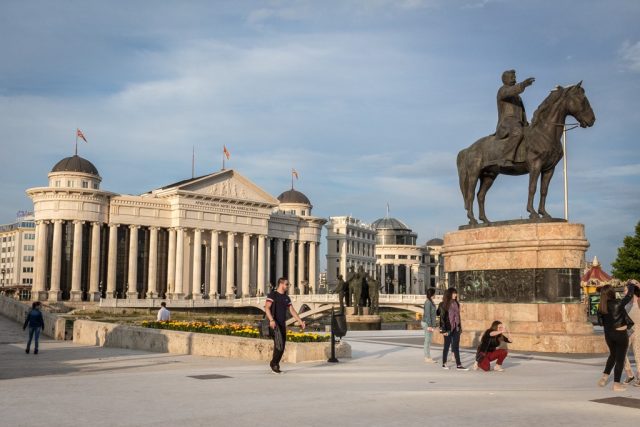
Skopje’s classical makeover may be both controversial and kitsch, but we couldn’t get enough of it!
Imagine if Mariah Carey decided to rebuild Ancient Rome… Thankfully, one doesn’t have to conjure up depictions of glitzy statues and wedding-cake style buildings, as such a place exists and it is called Skopje.
From faux neoclassical façades to willow trees plonked in the middle of the river, every nook and cranny of the city centre is an Instagramable dream.
For us gay travellers, it was Warrior on a Horse that did it.
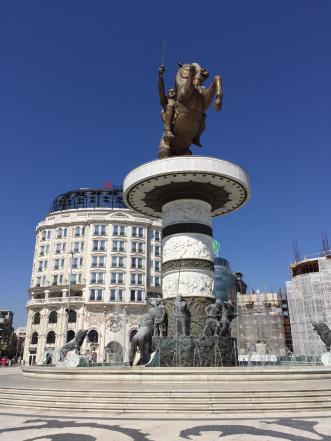 After an exhausting journey that involved travelling on a rickety, freezing and positively archaic Deutsche Bahn carriage from Pristina, we were thrown off the train on the Kosovo-Macedonia border – “train stop here today” was all we got from the guard – and, somehow, we flagged a taxi to take us the rest of the way.
After an exhausting journey that involved travelling on a rickety, freezing and positively archaic Deutsche Bahn carriage from Pristina, we were thrown off the train on the Kosovo-Macedonia border – “train stop here today” was all we got from the guard – and, somehow, we flagged a taxi to take us the rest of the way.
We were dropped off in the Macedonian capital in front of the socialist era Gradski Trgovski Centar (or GTC to those in the know). Built in 1973, this architectural hulk was the country’s first shopping centre and although handy for its supermarket, it certainly didn’t give any clues as to what was lying on the other side. We sauntered past mobile phone and shoe shops before emerging into glorious sunshine on Ploštad Makedonija (Macedonia Square) and it was then that we saw a fountain unlike anything I had ever seen before.
 At nearly 50 feet tall, Warrior on a Horse is a homoerotic sight to behold. Completed in 2011 to commemorate 20 years of the independence of Macedonia, the warrior (which is definitely not Alexander the Great, if anyone asks) sits on a cylindrical column that contains some of the largest kitchen downlights going. The central column consists of three large relief-laden ivory sections, each separated by a thinner metallic ring. Underneath, bronze lions gush out water from their mouths into a giant pool, which also sees jets of water leap upwards in beautiful synchronised patterns.
At nearly 50 feet tall, Warrior on a Horse is a homoerotic sight to behold. Completed in 2011 to commemorate 20 years of the independence of Macedonia, the warrior (which is definitely not Alexander the Great, if anyone asks) sits on a cylindrical column that contains some of the largest kitchen downlights going. The central column consists of three large relief-laden ivory sections, each separated by a thinner metallic ring. Underneath, bronze lions gush out water from their mouths into a giant pool, which also sees jets of water leap upwards in beautiful synchronised patterns.
From this moment on, we were hooked on Skopje, and, at this point, we hadn’t even seen the fountain lit up at night in garish pinks, purples and greens.
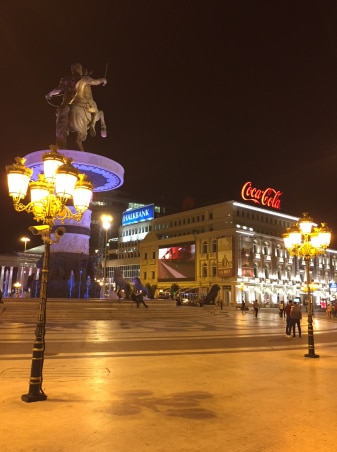 Bigger and bigger
Bigger and bigger
Just off Macedonia Square, we caught a glimpse of Porta Macedonia, a 21 metre-high triumphal arch covered in nearly 200 square metres of reliefs carved in marble, depicting scenes from the history of the country but looking as new and well-made as a cheap ceiling rose from B&Q.
 Suddenly, a red double decker bus whooshed past us and for a moment I thought I was back in the UK. However, in a city that truly embodies the phrase ‘all fur coat and no knickers’, Skopje’s current generation of retro Routemaster-esque buses have never seen any action in London, instead, they were born in China’s Zhengzhou Yutong factory in 2011.
Suddenly, a red double decker bus whooshed past us and for a moment I thought I was back in the UK. However, in a city that truly embodies the phrase ‘all fur coat and no knickers’, Skopje’s current generation of retro Routemaster-esque buses have never seen any action in London, instead, they were born in China’s Zhengzhou Yutong factory in 2011.
Elsewhere, the statues themselves kept coming, and didn’t seem to be getting any smaller. After dropping off our bags in the hotel we crossed the 15th-century Kameni Most (Stone Bridge) to be greeted by another near-50-footer, this time depicting a Warrior (no horse and definitely not Philip II of Macedon, if anyone asks). Also in Rebellion Square, we stopped to admire an oversized female breastfeeding in bronze as part of the Fountain of the Mothers of Macedonia. Fortunately, the said woman’s breasts did not spurt out water, but we figured it would be only a matter of time before this tweak is made.
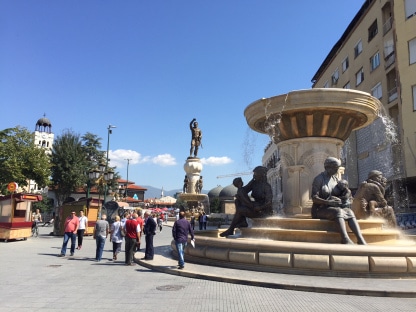 Along the Vardar
Along the Vardar
The Čaršija (Old Bazaar) looked far too historic and authentic for our liking, so we turned around at this point and continued our journey along the North Bank of the Vardar River. With its tall columns and huge glass windows, we immediately got snap happy at the sight of the Museum of Archaeology.
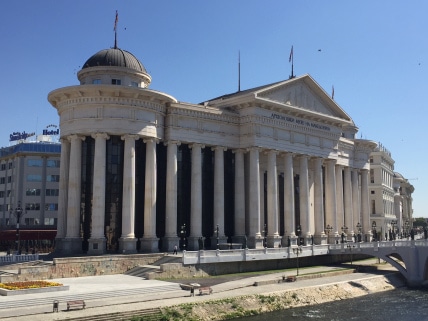 Along with similar structures in the city centre, this building is clearly all about the façade, with not much going on behind it; think the architectural equivalent of a painstakingly-decorated pancake. Inside, the museum was laid out like a dimly-lit Ernest Jones, although the security guards here seemed more bothered about stopping us from taking photographs than protecting the cultural gems themselves.
Along with similar structures in the city centre, this building is clearly all about the façade, with not much going on behind it; think the architectural equivalent of a painstakingly-decorated pancake. Inside, the museum was laid out like a dimly-lit Ernest Jones, although the security guards here seemed more bothered about stopping us from taking photographs than protecting the cultural gems themselves.
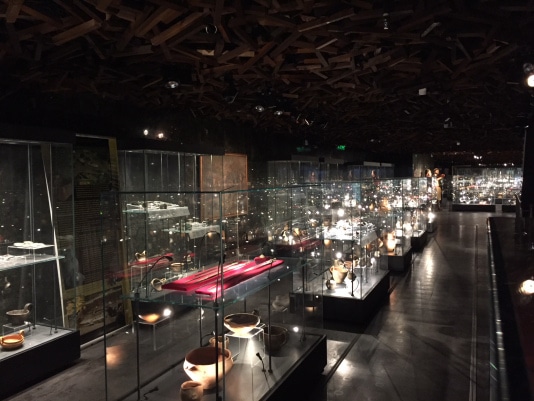 Back in the sunshine we were serenaded by the classical music – and occasional Christmas songs (we visited in September) – pumped out into the streets.
Back in the sunshine we were serenaded by the classical music – and occasional Christmas songs (we visited in September) – pumped out into the streets.
River a bit pithy? No worries, just shove a few fountains and gigantic plant pots in it! Oh, and why not add some pirate ships for good measure? This is town planning inspired by ‘Pirates of the Caribbean’ at its very best.
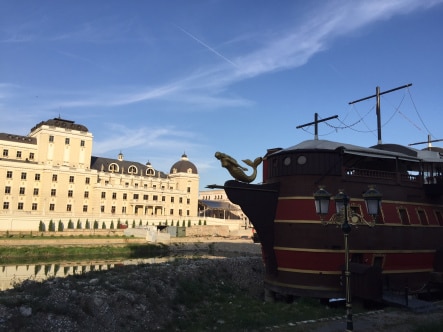 We crossed over the stream-like Vardar over the Eye and Art bridges, with 28 and 29 statues respectively depicting great Macedonian leaders, philosophers, artists and musicians – all overwhelmingly male. Since opening in 2013, there have been reports of the Eye Bridge’s marble railing cracking and indications that there were deficiencies in its design, but we didn’t care when there was a statue to photograph at each step. Plus, at one end of the Art Bridge lies the Financial Police Building, which, with its cylindrical body and dome-shaped roof, seems a little wasted upon those who work inside it, but at least it looked fabulous with a Clarendon filter.
We crossed over the stream-like Vardar over the Eye and Art bridges, with 28 and 29 statues respectively depicting great Macedonian leaders, philosophers, artists and musicians – all overwhelmingly male. Since opening in 2013, there have been reports of the Eye Bridge’s marble railing cracking and indications that there were deficiencies in its design, but we didn’t care when there was a statue to photograph at each step. Plus, at one end of the Art Bridge lies the Financial Police Building, which, with its cylindrical body and dome-shaped roof, seems a little wasted upon those who work inside it, but at least it looked fabulous with a Clarendon filter.
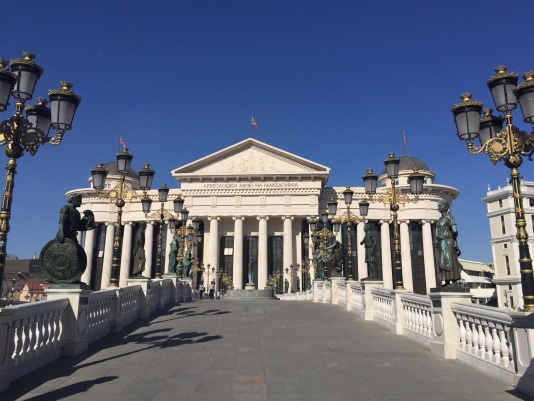 Shining lights
Shining lights
As well as the statues, Parisian streetlights have been seemingly plonked at 20cm intervals on both bridges and were most enjoyed by the thousands of moths that gathered around their luminescence come sundown. Moths aside, it was at night that this tacky capital truly showed its camp side; by day, the statues ooze testosterone, by night they reveal their inner divas. A sea of ever-changing lights washes the façades and statues in glorious technicolour, making a quiet drink in one its squares feel like a packed dancefloor during pride, with occasional musical interludes and gallons of water gushing at you from all angles.
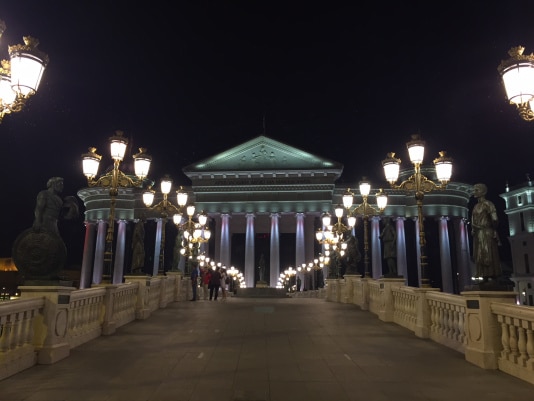
As luck would have it, we were in town on 8 September, Macedonia’s Independence Day, and it was marked with a red and yellow light show on the city’s main buildings, echoing the colours of the country’s flag.
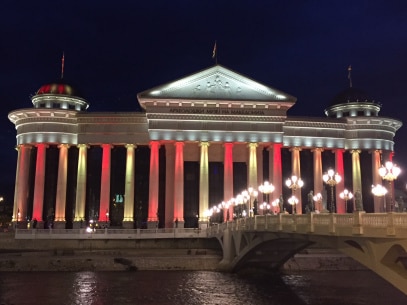 Plus, if the city lights aren’t enough, in the distance on the top of Vodno Mountain stands the 66-metre Millennium Cross which shines bright down towards the urban area at night. Christianity is evident throughout the streets too, with various quotes from Skopje-born Mother Teresa on plaques across the city centre giving a much-required feminine touch to the macho statues everywhere else.
Plus, if the city lights aren’t enough, in the distance on the top of Vodno Mountain stands the 66-metre Millennium Cross which shines bright down towards the urban area at night. Christianity is evident throughout the streets too, with various quotes from Skopje-born Mother Teresa on plaques across the city centre giving a much-required feminine touch to the macho statues everywhere else.
Looking like a university architecture project that should have remained at concept stage, the Memorial House of Mother Teresa finds its home amid a popular shopping and leisure promenade, Macedonia Street. The building oozes nothing that suggest it is a memorial or religious refuge and, although there are some interesting relics inside, there’s very little to garner about the saint’s rich life other than a few photographs of her meeting some celebrities and visiting her birthplace in her old age.
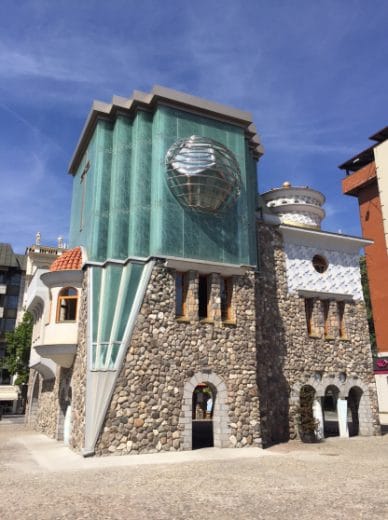 #FYROMfails
#FYROMfails
Back to the kitchness, not everyone is happy with how Skopje is trying to reinvent itself, and front of the queue to rain on Macedonia’s multi-coloured parade is Greece. Ever wondered why Macedonia is announced with the FYR prefix on Eurovision? Well, that’s Greece’s fault. Macedonia, sorry, the Former Yugoslav Republic of Macedonia (the United Nations goes with FYROM) borders a large region of Greece called, you guessed it, Macedonia.
The Republic of Macedonia is accused of appropriating symbols and figures that are historically considered part of Greek culture, such as Alexander the Great and his father, Philip II. Certainly gigantic statues that bear an uncanny resemblance to the aforementioned Ancient Greek figures don’t do FYROM any favours. Although a compromise is now on the cards, this debate has rumbled on for over 25 year since the breakup of socialist Yugoslavia, so don’t expect a definite resolution anytime soon.
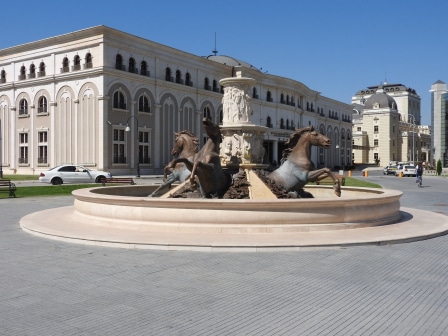 Furthermore, as we all know, flamboyance comes at a cost and, in carrying out one of Europe’s biggest urban renewal schemes, Skopje’s mega makeover has cost anywhere between 80 to 500 million euros, depending on who you ask. Officially known as Skopje 2014 (the date by which the Government hoped to have given the capital a more classical appeal by) from its inception in 2010, an impressive 136 structures were bankrolled by the state for the project. As you can imagine, critics to this building bonanza have suggested the money could have been spent elsewhere, the work could have been completed for far less money or there’s even those who feel that the construction of more modern buildings would have been more resourceful.
Furthermore, as we all know, flamboyance comes at a cost and, in carrying out one of Europe’s biggest urban renewal schemes, Skopje’s mega makeover has cost anywhere between 80 to 500 million euros, depending on who you ask. Officially known as Skopje 2014 (the date by which the Government hoped to have given the capital a more classical appeal by) from its inception in 2010, an impressive 136 structures were bankrolled by the state for the project. As you can imagine, critics to this building bonanza have suggested the money could have been spent elsewhere, the work could have been completed for far less money or there’s even those who feel that the construction of more modern buildings would have been more resourceful.
While the detractors may have a fair point, particularly given Macedonia’s high unemployment and poverty rates, Skopje’s nationalist kitsch is certainly bringing in the punters and we were surrounded by a multitude of languages and tour groups as we minced our way through the city.
LGBTQ rights
I’m sure you’ve already understood that by describing Skopje as ‘gay’, I am doing this with my tongue firmly in my cheek and basing it on an assumption that all male homosexuals are attracted to glitz, glamour and anything over-the-top. While that may be partly true, unfortunately – and now for the serious bit – despite being a potential mecca for gay tourism, Macedonia needs to undergo a serious step change in its treatment of LGBTQ communities before the pink denars start flooding in.
Despite the ostentatiousness around us in architecture form, there was no visible gay scene for us to explore as tourists. Certainly, when my fiancé and I checked in to the plush Hotel Solun & Spa, eyebrows were raised among the front of house staff when we asked for a double room. Of course, the situation for the wider population is generally tougher than for tourists who are just passing by, and online news reports showcase a country that is still inherently homophobic and positive change is a long way off, despite the best efforts of local groups such as the LGBTI Support Center and Equality for Gays and Lesbians (EGAL).
According to United States’ Macedonia 2012 Human Rights Report the LGBT community is prejudiced and harassed by the society, media and the government. Furthermore, there is very little protection against discrimination and there is no legal recognition for same-sex couples.
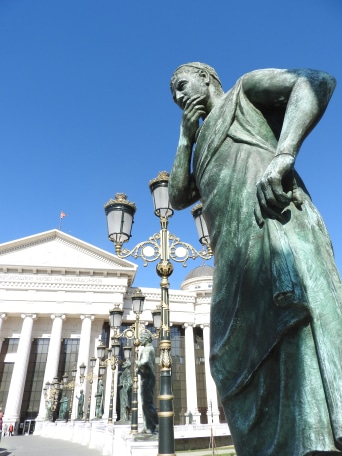 Just as the matt emulsion was peeling off some of the recently inaugurated façades, the openness of Skopje doesn’t, sadly, run skin deep and, unless a conscious effort is made at improving the situation for LGBTQ locals, Skopje will miss out on a huge audience it has seemingly being recreated to serve.
Just as the matt emulsion was peeling off some of the recently inaugurated façades, the openness of Skopje doesn’t, sadly, run skin deep and, unless a conscious effort is made at improving the situation for LGBTQ locals, Skopje will miss out on a huge audience it has seemingly being recreated to serve.
However, I would suggest you book your flights to Skopje sooner rather than later, as a Bulgarian news report suggests that that the over-the-top feel of the capital is set to be curtailed going forward.
In the meantime, I urge you all to vote Macedonia in next year’s Eurovision Song Contest. The party there would be incredible and the Skopje setting would be almost as gay as the main show itself. Plus, for those struggling under Macedonia’s archaic mentality, it would give them a new sense of belonging among their European counterparts and force the authorities to reconsider their stance with the glare of the world’s media and forward thinkers questioning why LGBTQ acceptance hasn’t come to Macedonia already.
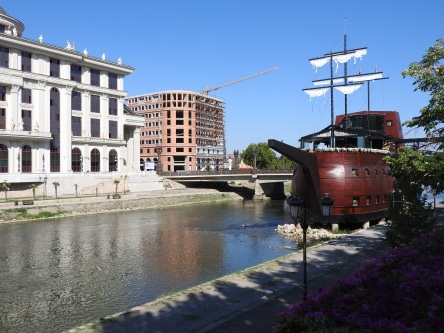
Have you been to Skopje? What were your highlights? Let me know in the comments below.
Article is taken from a personal blog of gay traveller.


